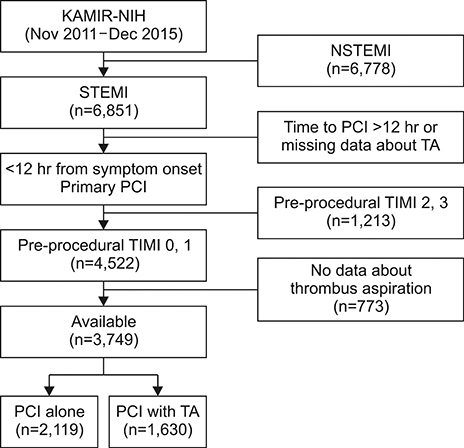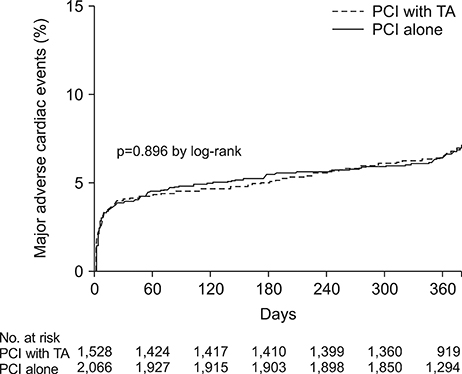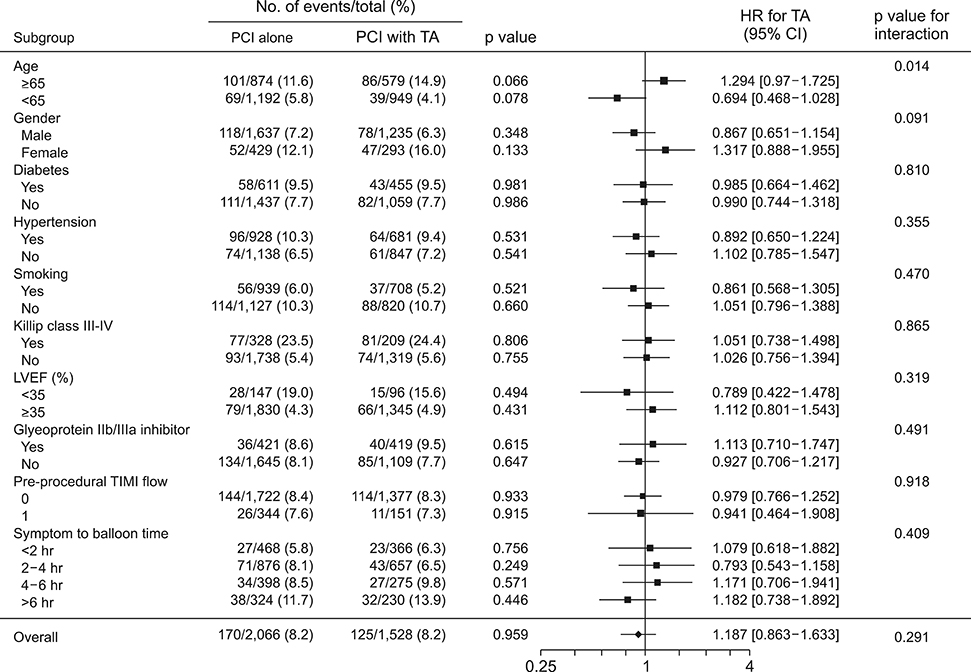Chonnam Med J.
2020 Jan;56(1):36-43. 10.4068/cmj.2020.56.1.36.
Impact of Thrombus Aspiration on Clinical Outcomes in Korean Patients with ST Elevation Myocardial Infarction
- Affiliations
-
- 1Division of Cardiology, Department of Internal Medicine, Chungnam National University Hospital, Daejeon, Korea. jojeong@cnu.ac.kr
- 2Chungbuk Regional Cardiovascular Disease Center, Department of Internal Medicine, Chungbuk National University College of Medicine, Cheongju, Korea.
- 3Department of Internal Medicine and Heart Center, Chonnam National University Hospital, Gwangju, Korea.
- KMID: 2468144
- DOI: http://doi.org/10.4068/cmj.2020.56.1.36
Abstract
- We evaluated whether thrombus aspiration (TA) during primary percutaneous coronary intervention (PCI) reduces adverse clinical outcomes within 30-days and 1-year periods. There is no well-designed, Korean data about the clinical impact of intracoronary TA during primary PCI in patients with ST-segment elevation myocardial infarction (STEMI). From the Korea Acute Myocardial Infarction Registry-National Institute of Health, 3749 patients with STEMI undergoing primary PCI within 12 hours (60.8±12.9 years, 18.7% women) with pre-procedural Thrombolysis in Myocardial Infarction (TIMI) flow 0, 1 in coronary angiography were enrolled between November 2011 and December 2015. The patients were divided into two groups: PCI with TA (n=1630) and PCI alone (n=2119). The primary end-point was major adverse cardiac event (MACE), defined as the composite of cardiovascular death (CVD), recurrent MI and stroke for 30-days and 1-year. TA did not diminish the risk of MACE, all-cause mortality and CVD in all patients during 30-days or 1-year. After performing the propensity score matching, TA also did not reduce the risk of MACE (Hazard ratio (HR) with 95% Confidence Interval (CI):1.187 [0.863-1.633], p value=0.291), all-cause mortality (HR with 95% CI: 1.130 [0.776-1.647], p value=0.523) and CVD (HR with 95% CI: 1.222 [0.778-1.920], p value=0.384) during the 1-year period. In subgroup analysis, there was no benefit of clinical outcomes favoring PCI with TA. In conclusion, primary PCI with TA did not reduce MACE, all-cause mortality or CVD among the Korean patients with STEMI and pre-procedural TIMI flow 0, 1 during the 30-day and 1-year follow ups.
MeSH Terms
Figure
Reference
-
1. Svilaas T, Vlaar PJ, van der Horst IC, Diercks GF, de Smet BJ, van den Heuvel AF, et al. Thrombus aspiration during primary percutaneous coronary intervention. N Engl J Med. 2008; 358:557–567.
Article2. Costopoulos C, Gorog DA, Di Mario C, Kukreja N. Use of thrombectomy devices in primary percutaneous coronary intervention: a systematic review and meta-analysis. Int J Cardiol. 2013; 163:229–241.
Article3. Vlaar PJ, Svilaas T, van der Horst IC, Diercks GF, Fokkema ML, de Smet BJ, et al. Cardiac death and reinfarction after 1 year in the thrombus aspiration during percutaneous coronary intervention in acute myocardial infarction study (TAPAS): a 1-year follow-up study. Lancet. 2008; 371:1915–1920.
Article4. Sardella G, Mancone M, Bucciarelli-Ducci C, Agati L, Scardala R, Carbone I, et al. Thrombus aspiration during primary percutaneous coronary intervention improves myocardial reperfusion and reduces infarct size: the EXPIRA (thrombectomy with export catheter in infarct-related artery during primary percutaneous coronary intervention) prospective, randomized trial. J Am Coll Cardiol. 2009; 53:309–315.
Article5. De Luca G, Dudek D, Sardella G, Marino P, Chevalier B, Zijlstra F. Adjunctive manual thrombectomy improves myocardial perfusion and mortality in patients undergoing primary percutaneous coronary intervention for ST-elevation myocardial infarction: a meta-analysis of randomized trials. Eur Heart J. 2008; 29:3002–3010.
Article6. Burzotta F, De Vita M, Gu YL, Isshiki T, Lefèvre T, Kaltoft A, et al. Clinical impact of thrombectomy in acute ST-elevation myocardial infarction: an individual patient-data pooled analysis of 11 trials. Eur Heart J. 2009; 30:2193–2203.
Article7. Jolly SS, Cairns JA, Yusuf S, Meeks B, Pogue J, Rokoss MJ, et al. TOTAL Investigators. Randomized trial of primary PCI with or without routine manual thrombectomy. N Engl J Med. 2015; 372:1389–1398.
Article8. Fröbert O, Lagerqvist B, Olivecrona GK, Omerovic E, Gudnason T, Maeng M, et al. TASTE Trial. Thrombus aspiration during ST-segment elevation myocardial infarction. N Engl J Med. 2013; 369:1587–1597.
Article9. Lagerqvist B, Fröbert O, Olivecrona GK, Gudnason T, Maeng M, Alström P, et al. Outcomes 1 year after thrombus aspiration for myocardial infarction. N Engl J Med. 2014; 371:1111–1120.
Article10. Ibanez B, James S, Agewall S, Antunes MJ, Bucciarelli-Ducci C, Bueno H, et al. ESC Scientific Document Group. 2017 ESC Guidelines for the management of acute myocardial infarction in patients presenting with ST-segment elevation: The Task Force for the management of acute myocardial infarction in patients presenting with ST-segment elevation of the European Society of Cardiology (ESC). Eur Heart J. 2018; 39:119–177.11. Levine GN, Bates ER, Blankenship JC, Bailey SR, Bittl JA, Cercek B, et al. 2015 ACC/AHA/SCAI focused update on primary percutaneous coronary intervention for patients with ST-elevation myocardial infarction: an update of the 2011 ACCF/AHA/SCAI guideline for percutaneous coronary intervention and the 2013 ACCF/AHA guideline for the management of ST-elevation myocardial infarction: a report of the American College of Cardiology/American Heart Association Task Force on clinical practice guidelines and the Society for Cardiovascular Angiography and Interventions. Circulation. 2016; 133:1135–1147.12. Ryan TJ, Bauman WB, Kennedy JW, Kereiakes DJ, King SB 3rd, McCallister BD, et al. Guidelines for percutaneous transluminal coronary angioplasty. A report of the American Heart Association/American College of Cardiology Task Force on assessment of diagnostic and therapeutic cardiovascular procedures (Committee on Percutaneous Transluminal Coronary Angioplasty). Circulation. 1993; 88:2987–3007.
Article13. Scanlon PJ, Faxon DP, Audet AM, Carabello B, Dehmer GJ, Eagle KA, et al. ACC/AHA guidelines for coronary angiography. A report of the American College of Cardiology/American Heart Association Task Force on practice guidelines (Committee on Coronary Angiography). Developed in collaboration with the Society for Cardiac Angiography and Interventions. J Am Coll Cardiol. 1999; 33:1756–1824.
Article14. Antman EM, Hand M, Armstrong PW, Bates ER, Green LA, Halasyamani LK, et al. 2007 Focused update of the ACC/AHA 2004 guidelines for the management of patients with ST-elevation myocardial infarction: a report of the American College of Cardiology/American Heart Association Task Force on practice guidelines: developed in collaboration with the Canadian Cardiovascular Society endorsed by the American Academy of Family Physicians: 2007 writing group to review new evidence and update the ACC/AHA 2004 guidelines for the management of patients with ST-elevation myocardial infarction, writing on behalf of the 2004 writing committee. Circulation. 2008; 117:296–329.
Article15. King SB 3rd, Smith SC Jr, Hirshfeld JW Jr, Jacobs AK, Morrison DA, Williams DO, et al. 2007 Focused update of the ACC/AHA/SCAI 2005 guideline update for percutaneous coronary intervention: a report of the American College of Cardiology/American Heart Association Task Force on practice guidelines: 2007 writing group to review new evidence and update the ACC/AHA/SCAI 2005 guideline update for percutaneous coronary intervention, writing on behalf of the 2005 writing committee. Circulation. 2008; 117:261–295.
Article16. Bavry AA, Kumbhani DJ, Bhatt DL. Role of adjunctive thrombectomy and embolic protection devices in acute myocardial infarction: a comprehensive meta-analysis of randomized trials. Eur Heart J. 2008; 29:2989–3001.
Article17. Elgendy IY, Huo T, Bhatt DL, Bavry AA. Is aspiration thrombectomy beneficial in patients undergoing primary percutaneous coronary intervention? Meta-analysis of randomized trials. Circ Cardiovasc Interv. 2015; 8:e002258.
Article18. Hachinohe D, Jeong MH, Saito S, Kim MC, Cho KH, Ahmed K, et al. Korea Acute Myocardial Infarction Registry Investigators. Clinical impact of thrombus aspiration during primary percutaneous coronary intervention: results from Korea Acute Myocardial Infarction Registry. J Cardiol. 2012; 59:249–257.
Article19. Sim DS, Jeong MH, Ahn Y, Kim YJ, Chae SC, Hong TJ, et al. other Korea Acute Myocardial Infarction Registry (KAMIR) Investigators. Manual thrombus aspiration during primary percutaneous coronary intervention: impact of total ischemic time. J Cardiol. 2017; 69:428–435.
Article20. Bajaj NS, Ather S, Gaba S, Aggarwal H, Arora P, Ghimire G, et al. Glycoprotein IIb/IIIa inhibitors improve mortality after aspiration thrombectomy in patients with ST-segment elevation myocardial infarction. Int J Cardiol. 2015; 187:206–207.
Article21. Stone GW, Maehara A, Witzenbichler B, Godlewski J, Parise H, Dambrink JH, et al. INFUSE-AMI Investigators. Intracoronary abciximab and aspiration thrombectomy in patients with large anterior myocardial infarction: the INFUSE-AMI randomized trial. JAMA. 2012; 307:1817–1826.
Article22. Sim DS, Ahn Y, Kim YH, Lee D, Seon HJ, Park KH, et al. Effect of manual thrombus aspiration during primary percutaneous coronary intervention on infarct size: evaluation with cardiac computed tomography. Int J Cardiol. 2013; 168:4328–4330.
Article23. Quadros AS, Cambruzzi E, Sebben J, David RB, Abelin A, Welter D, et al. Red versus white thrombi in patients with ST-elevation myocardial infarction undergoing primary percutaneous coronary intervention: clinical and angiographic outcomes. Am Heart J. 2012; 164:553–560.
Article24. van 't Hof AW, Liem A, Suryapranata H, Hoorntje JC, de Boer MJ, Zijlstra F. Angiographic assessment of myocardial reperfusion in patients treated with primary angioplasty for acute myocardial infarction: myocardial blush grade. Zwolle Myocardial Infarction Study Group. Circulation. 1998; 97:2302–2306.25. Gibson CM, Cannon CP, Daley WL, Dodge JT Jr, Alexander B Jr, Marble SJ, et al. TIMI frame count: a quantitative method of assessing coronary artery flow. Circulation. 1996; 93:879–888.
- Full Text Links
- Actions
-
Cited
- CITED
-
- Close
- Share
- Similar articles
-
- Comparison of the Signal-averaged ECG after Primary Percutaneous Coronary Intervention according to Thrombus Aspiration in ST Elevation Myocardial Infarction
- ST-Segment Elevation Acute Myocardial Infarction Secondary to Native Aortic Valve Thrombus
- Simultaneous Total Occlusion of Multiple Distal Coronary Arteries in Acute Myocardial Infarction
- Differences in Clinical Outcomes Between Patients With ST-Elevation Versus Non-ST-Elevation Acute Myocardial Infarction in Korea
- ST-Segment Elevation Myocardial Infarction as a Result of Coronary Artery Ectasia-Related Intracoronary Thrombus in a Patient with Liver Cirrhosis




